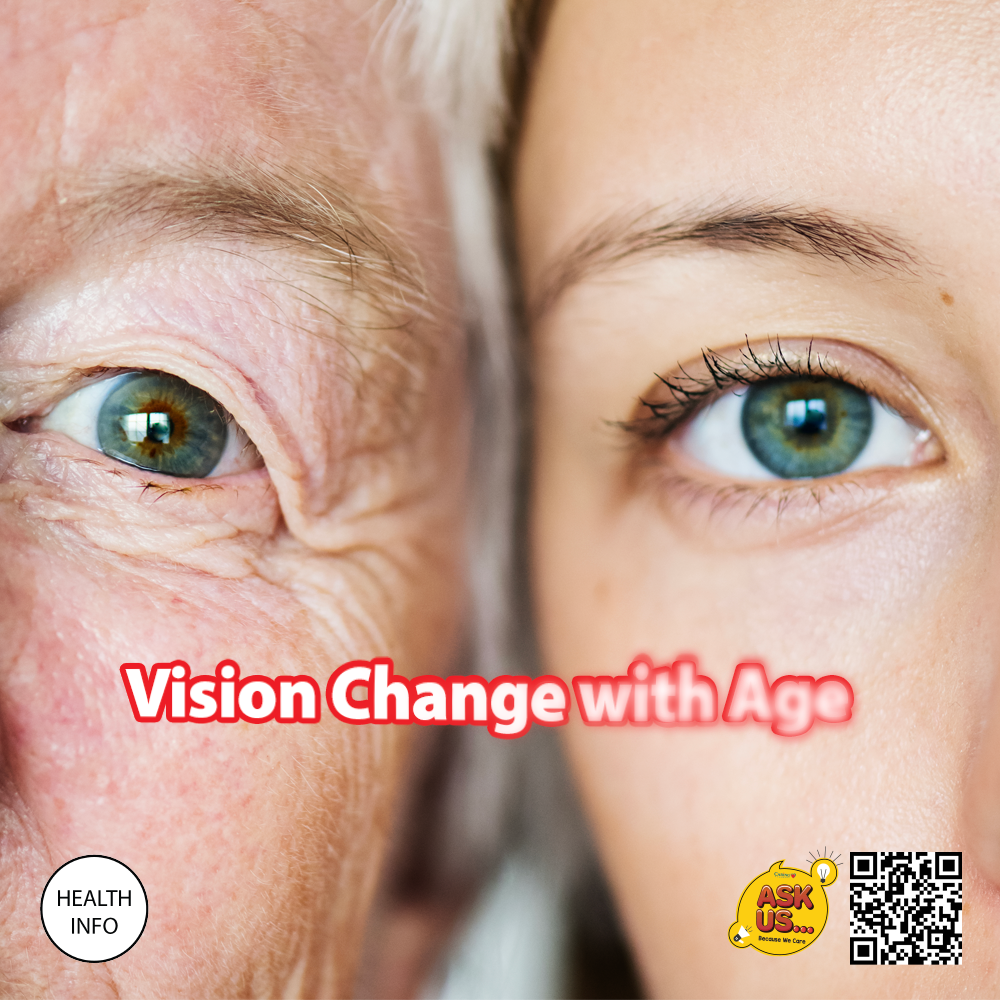
Vision development starts with limited sight in infancy (0-2 years), where babies gradually begin recognizing colors and developing depth perception by 6 months. This continues to refine throughout childhood (3-12 years). During adolescence (13-19 years), the onset of myopia (nearsightedness) is common, often requiring glasses. Vision typically remains stable in adulthood (20-40 years). However, around age 40, presbyopia (farsightedness) may begin, affecting close object focus and necessitating reading glasses. Middle age (40-60 years) sees the progression of presbyopia and an increased risk of cataracts, glaucoma, and age-related macular degeneration (AMD). In the elderly (60+ years), vision impairment from cataracts and AMD is common, and glaucoma risk increases.¹⁻² Thus, regular eye exams are essential for early detection and management of these changes to maintain quality of life.
Common Age-Related Vision Problems: ³⁻⁴
1. Presbyopia
- Description: Age-related loss of the eye’s ability to focus on nearby objects.
- Symptoms:
- Difficulty reading small print.
- Needing to hold reading materials at arm’s length.
- Eye strain or headaches when reading or doing close work.
- Blurred vision at normal reading distance.
- Management:
- Using reading glasses to correct vision
- LASIK (laser-assisted in situ keratomileusis) to reshape the cornea of the eye
2. Cataract
- Description: Clouding of the eye’s natural lens.
- Symptoms:
- Blurry or dim vision.
- Difficulty seeing at night.
- Sensitivity to light and glare.
- Seeing halos around lights.
- Faded colors.
- Management:
- Regular eye exams to monitor progression.
- Surgical removal of the cloudy lens when vision impairment affects daily activities.
3. Age-Related Macular Degeneration (AMD)
- Description: Degeneration of the central part of the retina (macula).
- Symptoms:
- Blurred or wavy central vision.
- Diminished color perception.
- Management:
- Regular eye exams to detect early signs.
- Dietary supplements (Vitamin A, DHA, lutein, zeaxanthin).
- Use of magnifying and adaptive devices for daily tasks.
4. Glaucoma
- Description: Group of eye conditions damaging the optic nerve, often due to high eye pressure.
- Symptoms:
- Severe eye pain (in acute angle-closure glaucoma).
- Nausea and vomiting.
- Sudden onset of visual disturbance.
- Halos around lights.
- Redness in the eye.
- Management:
- Prescription eye drops or oral medication to reduce intraocular pressure.
- Laser therapy or surgery to improve fluid drainage from the eye.
- Regular check-ups to prevent optic nerve damage.
5. Diabetic Retinopathy
- Description: Damage to the blood vessels of the retina due to diabetes.
- Symptoms:
- Spots or dark strings floating in vision (floaters).
- Blurred or fluctuating vision.
- Dark or empty areas in vision.
- Vision loss.
- Management:
- Strict control of blood sugar, blood pressure, and cholesterol.
- Regular dilated eye exams.
6. Dry Eyes
- Description: Condition where tears cannot provide adequate lubrication for the eyes.
- Symptoms:
- Stinging, itching or burning sensation.
- Redness in the eyes.
- Watery eyes (body’s response to irritation).
- Management:
- Using artificial tears or lubricating eye drops to replace natural tears.
- Reducing screen time and using humidifiers to provide moisture to the eyes and reduce moisture loss.
- Prescription medications to increase tear production or reduce inflammation.
Importance of Regular Eye Checkups ⁵
Regular eye checkups are crucial, especially as we age, for early detection and management of age-related vision problems. Early detection allows proper treatment, preventing or slowing vision loss and ensuring better overall eye health and quality of life. The frequency of eye check-ups according to age group are as follows:
- Under 40 years old: Every 2-4 years.
- Ages 40-54: Every 2-3 years.
- Ages 55-64: Every 1-2 years.
- 65 years and older: Every year.
Individuals with specific risk factors, such as diabetes, a family history of eye disease, or those already diagnosed with an eye condition, should have more frequent check-ups as recommended by their eye care professional.
It is never too late to start caring for your eyes. Consult your doctor or pharmacist to understand your current vision condition and learn precautionary measures to prevent progression. Staying proactive about eye care is crucial to ensure better vision and quality of life as you age.
References:
- Vision Development and Milestones [Internet]. Optometrists Network; 2020 [cited 2024Jun28]. Available from: https://www.optometrists.org/childrens-vision/guide-to-visual-development/guide-to-vision-development/
- When Do Your Eyes Stop Growing [Internet]. Vision Center; 2024 [cited 2024Jun28]. Available from: https://www.visioncenter.org/conditions/how-your-eyes-grow/
- Aging and Your Eyes [Internet]. National Institute on Aging; 2021 [cited 2024Jun28]. Available from: https://www.nia.nih.gov/health/vision-and-vision-loss/aging-and-your-eyes
- How to Maintain Vision As You Age [Internet]. WebMD; 2023 [cited 2024Jun28]. Available from: https://www.webmd.com/healthy-aging/how-to-maintain-vision-as-you-age
- Adult Vision: 41 to 60 Years of Age [Internet]. AMERICAN OPTOMETRIC ASSOCIATION; 2024 [cited 2024Jun28]. Available from: https://www.aoa.org/healthy-eyes/eye-health-for-life/adult-vision-41-to-60-years-of-age?sso=y
Latest Health Info
Healthy Weight, Happy Joints
How Does Weight Affect Knee Health? The Link Between Pounds And Pain Osteoarthritis (OA) involves the degeneration of joints, which ...
The Gut Warriors: Prebiotics, Probiotics and Postbiotics
When it comes to gut health, you’ve probably heard of prebiotics and probiotics. But did you know there’s also ...
Tip Moreh: Masa Berbuka Puasa
Moreh adalah tradisi unik yang biasanya diadakan selepas solat tarawih pada bulan Ramadan. Ia melibatkan penyediaan dan perkongsian makanan ringan ...




